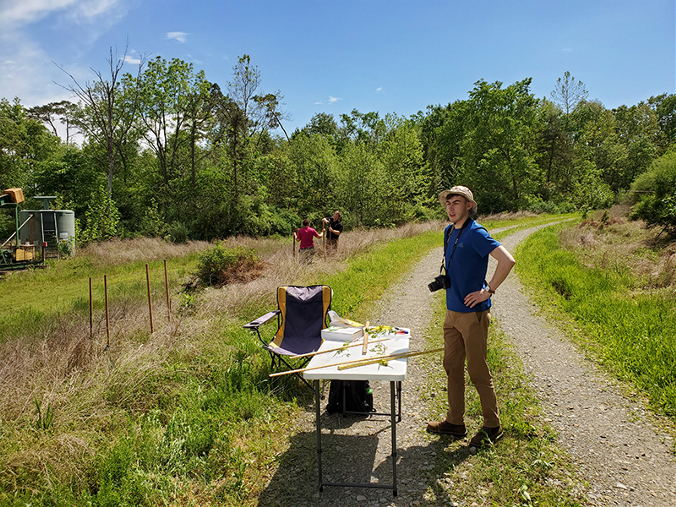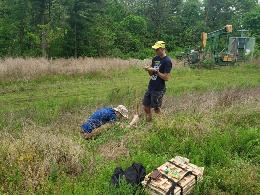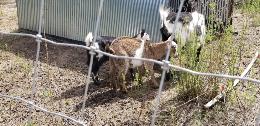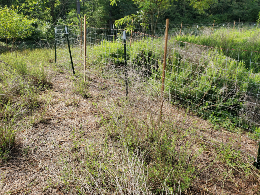SVC Senior, Professor Study Effectiveness of Goats in Controlling Vegetation
SVC Senior, Professor Study Effectiveness of Goats in Controlling Vegetation
-
Side Navigation
- Saint Vincent Benedictine Monks Continue Epiphany Tradition
- Update on Saint Vincent College Summer Theatre
- KCOE to Host Webinar Series on Lean Six Sigma, Lean Management
- December Commencement, Spring Academic Calendar Updates Announced
- McKenna Students Complete SAP Business One Training
- Virtual Info Session Planned for Management: Operational Excellence Grad Program
- Jeri Eckhart Queenan to Receive Honorary Degree, Deliver Commencement Address
- Saint Vincent College to Hold Virtual December Commencement
- Inaugural Fellows Selected for Gretsch Fellowship in Children's Music at the Fred Rogers Center
- Concert Series Resumes with Special Virtual Performance
- Dr. Sarah Daly Edits Book Exploring "Theories of Crime Through Popular Culture"
- McCarl Coverlet Gallery to Host Virtual Holiday Programming
- Andrew Kunz to Serve as Treasurer of SGA Executive Board
- 2021 SGA Executive Board Installed in Gavel Ceremony
- Sarah Centore Elected Secretary of SGA Executive Board
- Robert Gigliotti to Serve as SGA Executive Board President
- Alaina Dorazio Reelected VP of SGA Executive Board
- Music at Midday Series to Welcome Violinist Cara Garofalo
- Special Awards of Achievement Presented During Founders' Day
- Professor Michelle Gil-Montero Recognized with Projektenmacher Award
- Dr. Julia Cavallo Appointed Executive Director of ABCU
- New 'Music at Midday' Series Kicks off with Cellist Rachel Smith
- Dr. Jason King Honored with Thoburn Excellence in Teaching Award
- Graduate Program Receives High Marks for Value
- Engineering Students Named Clare Boothe Luce Scholars
- SVC Professor Explores Women of the New Testament in New Book
- McKenna School Students to Take Part in Virtual Conference
- Center for Catholic Thought and Culture Earns National Recognition
- SVC Players Prep for First Virtual Production
- Eulalia Books Releases First Full-Length English Translation of Colombian Woman Poet
- SVC Awarded Federal Grant to Support Student Success
- SVC Selected to Host 2022 NCAA D-III Volleyball Championship
- Saint Vincent College Players Set for Virtual Play
- Justin Fabin Named New Chief Information Officer
- SVC Players' Virtual Performance Now Available for Viewing
- Construction Begins on Student Life and Hospitality Center
- SVC Listed Among Nation's Best in College Factual Rankings
- Saint Vincent College Announces 2020 Alumni of Distinction
- Ofrenda on Display to Commemorate Día de los Muertos
- Major Exploration Day for Prospective Students Scheduled Nov. 11
- SBDC to Present 'Surviving the Pandemic' Webinar
- SVC Criminology Professor Explores Police Response to Mental Health Calls in New Book
- Rising Senior Awarded Alpha Lambda Delta Scholarship
- PAC Announces Athletic Scheduling Changes for Fall 2020
- SVC Professor Explores Aquinas's Thought in New Book
- Rising SVC Sophomore Lauded in Essay Competition
- A Message from the Alumni Relations Office
- SVC Alumni Council Holds First Virtual Meeting
- SVC Senior, Professor Study Effectiveness of Goats in Controlling Vegetation
- SVC Faculty Member Featured on Industry Podcast
- SBDC to Provide COVID-19 Assistance to Small Businesses
- Data Science, Business Data Analytics Big Part of SVC Grad's Career
- SVC Alum, Administrator Recognized on 40 Under 40 Listing
- SVC Earns High Marks in Money Magazine Rankings
- McKenna School Faculty Member Appointed to Editorial Positions
- SGA Election Results Announced
- SVC ROTC Cadets, Benedictines Complete Stair Climb for 9/11
- SVC Ranked in Top Tier of National Liberal Arts Colleges by U.S. News
- Eulalia Books to Host Series of Virtual Workshops
- SVC Announces Updated Commencement Plans
- Virtual Homecoming and Fall Family Weekend Events Planned Sept. 23-27
- SVC Senior Showcases Writing Skills as Contributor to Newspaper Serial
- Eleven Boyer School Grads Accepted into Allied Health Programs
- Graduates of Boyer School to Pursue Advanced Degrees
- Boyer School Graduates Accepted into Graduate, Medical, Allied Health Programs
- Virtual Get Acquainted Day Planned June 13
- Senior Student-Athlete Awards Announced
- A Message from President Rev. Paul R. Taylor, O.S.B.
- Equestrian Club Takes Part in Virtual Event
- New Start Date for Fall 2020
- SVC to Resume Campus Visits
- SVC Alumna Wins Literary Award
- Faith and Reason Day Camp Registration Open
- Fred Rogers Center Accepting Applications for Gretsch Fellowship
- Spring Dean's List Announced
- SVC Faculty Member Wins Award in Film Competition
- 2019 SVC Grad Awarded Fellowship
- Saint Vincent College, Seminary Graduate Named Bishop of Greensburg Diocese
- Father Martin de Porres Bartel, O.S.B., Elected Twelfth Archabbot, Named Chancellor
- Participants Sought for Online COVID-19 Impact Study
- Cybersecurity Program Earns National Recognition
- Mass for the Blessing of Archabbot Martin
- Dr. Jeff Mallory Appointed Executive Vice President
- Dr. Paul Follansbee Named Winner of Wimmer Faculty Award
- Aaron Sams Honored with Quentin Schaut Faculty Award
- Jessica Gibbs Named 2020 President's Award Recipient
- Tulk Announces Retirement; Wilfong Named Head Men's Lacrosse Coach
- Virtual Academic Conference Launched
- SVC Mourns the Loss of Distinguished Alum Herman K. Dupré, C'53
- Registration for Summer Courses Open
- Digital Exhibition Showcases Work of Students
- Center for Catholic Thought and Culture Launches Weekly Virtual Happy Hour
- SVC Administrator Wins Regional Honor
- Three Hundred Twenty-Five Students Awarded Degrees
- SVC Addresses Plans for Fall Semester
- Special Memorial Day Service to Be Streamed
- Virtual 5K to Support Student Emergency Fund
- McKenna School Graduates Accepted into Graduate, Ph.D. Programs
- AHSS Students to Pursue Advanced Degrees
- SVC Grad Published in National Outlets
- Boyer Grads Accepted into Professional Health Programs
- Library, Art Center Dedication Postponed
- Boyer School Donates Lab Supplies to First Responders, Medical Personnel
- SVC Grad's Virtual Art Lessons Earn Strong Response
- Saint Vincent College Awards Bachelor's, Master's Degrees at Virtual December Commencement
- McKenna School Faculty Member Featured on Podcast
- Greensburg Salem Students Sweep Pasta Bridge Competition
- Rogers Center, Global Instruments Brand Gretsch Establish Fellowship in Children's Music
- SVC to Waive Test Score Requirements for 2020 Applications
- 2019-20 Issue of Saint Vincent Literary Magazine, Generation, Released
- Students Selected for Lambda Pi Eta Honor Society
- SVC to Commemorate Week of Prayer for Christian Unity
- SVC Golf Teams to Call Historic Latrobe Country Club Home
- SVC Junior Looks to Build Off Record-Breaking Season
- McCarl Coverlet Gallery Launches Digital Exhibit
- Update Regarding 2020 Commencement
- SVC Professor Publishes Full-Length Book of Poetry
- Easter Sunday Mass to be Streamed Live from Basilica
- SVC Grad on Front Lines of COVID-19 Battle
- History Department, Westmoreland Historical Society Launch COVID-19 Digital Archive
- SVC Professor Explores Progressivism in New Book
- Office of Admission Extends Deposit Deadline
- Saint Vincent College Announces Award Winners
- Equestrian Superstar to Visit SVC
- CPET Lecture Series Continues March 10
- Helen Kish Awarded Full-Tuition Wimmer Scholarship
- Visiting Writers Series to Welcome Erín Moure
- LEARN Series to Welcome Acclaimed Substance Abuse Therapist
- Deely/Maritain Lecture Series to Feature Dr. Farouk Seif
- 2019-20 SVC Concert Series Finale Slated March 14
- Annual Pasta Bridge Competition Returns March 9
- Rogers Center Unveils 'Fred Unboxed' Digital Exhibit
- Eulalia Books Plans Book Launch at National Conference
- SVC Senior Featured in Latrobe Art Center Exhibition
- SVC Professor Wins National Award for Billboard Design
- Get Acquainted Day Open House Slated April 4
- SBDC Hosts "Brand: The Ultimate Communicator" March 25 in Fayette County
- Havard Glee Club Cancels Tour
- 2020 Summer Theatre Schedule Announced
- SVC Concert Series Event to be Rescheduled
- Education Department to Offer Free K-12, Special Education Tutoring
- Classes to Be Conducted Online for Remainder of Semester
- 2020 Summer Theatre Season Canceled
- SVC Contingent Takes Part in March for Life
- Recent Grad Set to Begin Dream Job in Hometown
- Westmoreland County Career Expo Slated Feb. 26
- Samuel Bringman Awarded Top Prize in Wimmer Scholarship Competition
- Urick to Deliver 'Lunch and Learn' Presentation
- Tadeusz Horomanski Awarded Wimmer Scholarship
- Concert Series Continues with 'Pennsylvania Pipes!' Feb. 15
- Hempfield Area Duo Awarded Wimmer Scholarships
- Criminology, Law and Society Program Earns National Ranking
- Mass, Dinner Planned for Longtime Monk, Faculty Member
- Feb. 18 CPET Lecture to Feature Richard Avramenko
- SVC Players to Present 'Into the Woods'
- SVC Adds Dual Master's in Criminology, School Counseling
- LEARN Series to Host Virginia Tech Shooting Survivor March 17
- SVC Campus Ministry Holds IGNITE Retreat
- Joe Farrell, C'68, Next Speaker in Manoli Lecture Series
- 2020 December Virtual Commencement Address
- World-Famous Harvard Glee Club to Perform at SVC
- SBDC Hosts 'The First Step to Small Business Success' on March 11
- Education Department to Host 'Mindfulness in the Classroom' Presentation
- Registration Open for 2020 Faith and Reason Summer Program
- Ecumenical Prayer Service for Christian Unity Scheduled Jan. 19
- SVC Announces Addition of Men's Bowling Club Team
- SVC Grad Program Garners High Marks from U.S. News and World Report
- SVC Plans Info Session for Master of Management: Operational Excellence Program
- Upcoming CPET Lecture to Feature Dr. J. Daniel Hammond
- McCarl Gallery to Present "Technological Textiles"
- Dr. Sarah Daly to Take Part in Press Conference at State Capitol
- SVC Awarded Special 'It's On Us PA' Research Grant
- SBDC Hosts 'The First Step to Small Business Success' Feb. 12
- Martin Luther King Jr. Celebration Dinner Held at SVC
- SVC Concert Series to Feature Pianist Lee Jan. 25
- SVC Ranks Among Best Colleges for Financial Aid
- Physics, Volleyball Standout Takes One Giant Leap into Summer Program
- Martin Luther King Jr. Poetry Contest Winners
- SVC to Add Music Education Program
- Spring 2020 Planetarium Schedule Announced
- Firestone Named Head Golf Coach
- Epiphany Door Chalking Tradition Continues
- Saint Vincent College Names 621 Students to Fall Dean's List
- Get Acquainted Day Open House Slated Jan. 25
- SVC to Offer Free, One-Credit Courses to Accepted Students
- Christmas Masses to be Livestreamed from Basilica
- Eulalia Books Publication up for National Award
- Saint Vincent College Names 665 Students to Fall Dean's List
- Saint Vincent College Announces Updated Spring 2021 Academic Calendar
- SVC Mourns the Loss of Dr. Michael Botsko, Emeritus Professor of Mathematics
- SVC Mourns the Loss of Dr. Richard Wissolik, Professor Emeritus of English
- Saint Vincent College Announces Partnership with Cristo Rey Network
- A Message from SVC President Father Paul Taylor, O.S.B.
- Inaugural Address of Rev. Paul R. Taylor, O.S.B.
- News 2020

LATROBE, PA – Long known as Saint Vincent College’s resident bird expert, associate professor of biology Dr. James Kellam has been involved in the study of a different animal throughout the summer.
Kellam and senior student Ian Tracey have teamed up to study the effectiveness of goats in controlling the growth of the noxious weed lespedeza at the Municipal Authority of Westmoreland County’s (MAWC) Beaver Run Reservoir near Saltsburg. The reservoir serves as the source of supply for its George R. Sweeney Water Treatment Plant, which provides drinking water for more than 150,000 residents throughout the county.
 For the study, goats are being deployed to eat lespedeza plants at Beaver Run. Their fecal samples will then be collected by Tracey and taken to the greenhouse outside of the Sis and Herman Dupré Science Pavilion, where they will be mixed with potting soil. Tracey will then monitor the potting soil to determine whether the seeds successfully germinate or if they were killed by the digestive tracts of the goats.
For the study, goats are being deployed to eat lespedeza plants at Beaver Run. Their fecal samples will then be collected by Tracey and taken to the greenhouse outside of the Sis and Herman Dupré Science Pavilion, where they will be mixed with potting soil. Tracey will then monitor the potting soil to determine whether the seeds successfully germinate or if they were killed by the digestive tracts of the goats.
In the fall, new seedlings will be planted as part of the MAWC’s efforts to increase tree cover at the reservoir and their growth will be continually monitored.
Laura Blood, source water supervisor at the George Sweeney Treatment Plant, explained that noxious weeds such as lespedeza often out-compete tree seedlings, thus severely hampering the MAWC’s reforestation goals.
“We want to make sure we identify and overcome any obstacles to tree growth in order to ensure our reforestation goals,” she said. “This goat study will allow us to make data-based decisions to ensure a thoughtful, well-informed approach to overcoming obstacles on the path to meeting these goals.”
 Tracey, a biology major and history minor from Pittsburgh, explained the multi-faceted project.
Tracey, a biology major and history minor from Pittsburgh, explained the multi-faceted project.
“We looked at the lespedeza height before and after goat treatment,” he said, “and will compare that to the control, where no goats are. We want to see if the species diversity increases due to the lespedeza being removed, which frees up more resources and allows more species to flourish. And, finally, we’re going to see if the goats’ intestinal tract can destroy the seeds. That would be fantastic.”
The study was born during a bird-watching excursion Kellam made to Beaver Run in January, where he first met Blood.
“After we talked about birds and my job at the College,” recounted Kellam, “she wondered if any Saint Vincent students may be interested in studying lespedeza on MAWC lands adjacent to the reservoir. I said that I thought I could find someone to help her. Laura already had a rough idea of what should be done, but wanted our involvement to ensure the study was done with scientific rigor.”
“I jumped at the chance to ask about potential collaborations with a few different projects,” said Blood. “The timing seemed to line up well with Dr. Kellam’s student projects and the goat project seemed like the best fit.”
Over the subsequent weeks, Kellam met with his students who were assigned to do research and after gauging their interests and Tracey jumped at the chance to take part in the lespedeza study.
 “I have always been interested in botany,” said Tracey. “For example, in high school, I planted a seed of corn that eventually grew to more than six feet tall. There is also a big patch of invasive plants - Japanese knotweed - behind our house, and I’ve tried many methods of eradicating them, which have proved useless. So, when I expressed this interest to Dr. Kellam, I was excited when he mentioned that he had a project that was perfect for me.”
“I have always been interested in botany,” said Tracey. “For example, in high school, I planted a seed of corn that eventually grew to more than six feet tall. There is also a big patch of invasive plants - Japanese knotweed - behind our house, and I’ve tried many methods of eradicating them, which have proved useless. So, when I expressed this interest to Dr. Kellam, I was excited when he mentioned that he had a project that was perfect for me.”
The practice of using goats to control vegetation is becoming more commonplace and Tracey feels that this is due to a multitude of reasons.
“We could use pesticides,” he said, “which would be very effective and inexpensive, but are environmentally hazardous. We could use physical labor, which would be effective and environmentally safe, but expensive. Goats are cheap compared to hired workers, so they are a satisfactory union of these three concerns – cost, environmental friendliness and effectiveness.”

“Goats are relatively inexpensive and economical. Our study will determine how effective they are, both in the short term and longer term.”
While controlling the growth of invasive weeds such as lespedeza is an important step in reforestation efforts, Tracey pointed out that it is also imperative to properly plan the planting of new trees.
“There have been many studies regarding this topic,” said Tracey, “and one of the things I noticed that remediation efforts often get wrong is the process of planting trees. This is far too commonly a second thought. The plants are sort of picked out randomly without regard to biodiversity, or they are just placed in a grid-like fashion. That’s not a natural formation. If the land is going to be remediated, the plants need to be diverse and placed in a way that’s as close to nature as possible. Biodiversity is important because it encourages resilience. If the trees are all the same species, if one gets sick and dies, they all get sick and die.”

“Ian and Dr. Kellam have been great to work with,” she said. “We had to have several virtual meetings and have had to be very adaptable with the impacts of COVID-19, the weather and growth rates. They are very hard workers. Ian is extremely ambitious and has exceeded my expectations of the amount of work he can get done in a day. He is very excited about botany and it has been a joy to share my past history of botany with him and Dr. Kellam.”
---
PHOTO 1: Ian Tracey looks over the study site at Beaver Run Reservoir
PHOTO 2: Lespedeza at the Beaver Run Reservoir
PHOTO 3: Ian Tracey (left) and Dr. James Kellam at work
PHOTO 4: The goats in action at the Beaver Run Reservoir
PHOTO 5: The difference in vegetation after the goat treatment (left side of fence) and the section that did not receive goats
PHOTO 6: The Beaver Run Reservoir
*click on photos to enlarge*
---
FOLLOW SAINT VINCENT COLLEGE ON SOCIAL MEDIA
Twitter: @MySaintVincent
Facebook: http://www.facebook.com/saintvincentcollege
Instagram: @SaintVincentCollege
YouTube: Saint Vincent College
Snapchat: MySaintVincent
